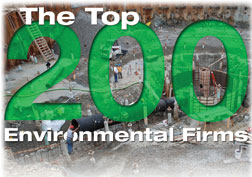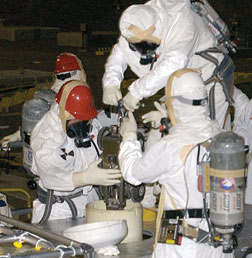 Photo: C. H. Nickerson |
In both the private and public sectors, sustainability and attention to resource cleanup, protection and reuse are the trends of the day. The Top 200 Environmental Firms have been engaged in all sectors of the green marketplace for years, even decades. Now, they are reaping new rewards from this growing cachet of environmental correctness. Infrastructure spending, buoyant economies and the firms’ own push for size and payback are combining to generate another year of solid results for the Top 200. But some executives worry about signs of trouble that could stunt firm growth a little, or a lot.
Total revenue for the Top 200 in 2006 climbed 12.5% to $42.2 billion, another positive result to add to the previous year’s 13.6% hike and a four-year trend of upward market growth overall and in most key environmental market segments.
 CH2M Hill Nuclear waste cleanup, such as at DOE’s Hanford site, is maturing but not over.
|
The strength of the U.S. market alone kept many environmental firms close to home. Domestic revenue grew 13.4% in 2006 to $36.4 billion. But firms are also following clients around the world or benefitting from new funding sources for cleanup and infrastructure upgrade and expansion abroad, as well as new environmental awareness. “We had a great year last year, and it was all organic,” says Richard Fox, CDM president. “Growth came in all of our sectors: water, remediation, municipal, private and federal.”
The Top 200’s international revenue rose 7.4% to $5.8 billion in 2006. Asia’s flat market a year ago has abruptly reversed itself in the 2007 survey. The same number of firms reporting revenue there in the last two years saw a 65.1% rise in 2006.
Some results among the 2007 Top 200 are related to changes in the firms participating. The list’s growth rate might have been more significant if one potential behemoth had been included. EnergySolutions, a Utah-based nuclear waste cleanup and management giant, last year acquired two former key players on the list, BNFL and GTS Duratek, and did not participate as it reportedly prepares to go public.
|
Changing Faces.
Even without EnergySolutions, the list is robust. CH2M Hill Ltd. retained its top spot, increasing environmental revenue by more than $550 million. Bechtel dropped to third place, with environmental revenue likely lost to new work in other booming construction sectors, but The Shaw Group Inc. zoomed from 12th place to fourth on the strength of its domestic waste cleanup work.
Two more firms—MWH Global Inc. and Black & Veatch—joined the nine others in the billion-dollar club, and two others, Earth Tech Inc. and AECOM Technology Corp., are just shy of that figure and could become members next year. “Markets are very healthy right now,” says Steven Guttenplan, CEO of AECOM environmental subsidiary Metcalf & Eddy Inc. “In the last three to four years, we have had a strong sustained volume of growth.”
Environmental Resources Management, formerly The ERM Group, held onto its position as the leading firm with 100% of its revenue from environmental work, increasing the total by more than $65 million. Malcolm Pirnie rose to second place, greatly assisted by the departure of BNFL and Duratek.
Green Machine
This year’s Top 200 list is supported by additional environmental market data from design firms that participated in ENR’s separate Sourcebook survey. Tables that show design-firm revenue rankings in selected environmental breakout markets such as asbestos abatement and sanitary and storm sewer work are displayed on pp. 45-49.
Former Vice President Al Gore’s 2006 movie, “An Inconvenient Truth,” about the perils of global warming and climate change spurred by greenhouse-gas emissions, resonated with people around the world and their leaders.
“Politicians are willing to spend more money than they might have otherwise,” says Robert B. Uhler, CEO of MWH Global. “The issues used to be crime, housing and pensions. Now it’s global warming. This is tilting some projects to go that would have been on the cusp.”
Total Top 200 revenue rose 12.5% to $42.2 billion. |
Adds Dale Sands, senior vice president at Earth Tech, “We are at the tipping point for the growth of sustainable development with a more universal movement to minimize a company’s footprint and environmental effects while achieving compliance. We’re talking about energy management, water use and reuse, natural resources and optimization of industrial processes to produce less waste and consume less energy.”
Green issues are a top priority of the now Democrat-ruled 110th Congress. More than 70 global warming bills, amendments and resolutions related to global warming have been introduced since the beginning of 2007. Most measures would require a reduction in carbon emissions, some calling for traditional cap-and-trade measures and others demanding more research into such technologies as carbon capture and sequestration.
The energy bill passed by the Senate last month includes provisions that would encourage research and development into renewable energy sources, as well as more reliance on renewable energy.
Both Sen. Barbara Boxer (D-Calif.), chair of the Senate Environment and Public Works Committee, and Speaker of the House Nancy Pelosi (D-Calif.) have vowed to pass legislation that would put caps on carbon dioxide emissions. And in another sign of federal lawmakers’ green commitment, the House of Representatives voted in March to establish a new Select Committee on Energy Independence and Global Warming, chaired by Rep. Edward Markey (D-Mass.)
Kent Angelos, vice president of Golder Associates Inc., says some clients have sought assistance with carbon-capture and sequestration technology. “We are actively working on a project in the U.S.” he says. “Not only are we looking at other projects in that area, but our existing clients are coming to us and asking us to consider these issues as we work on their permitting and assessment projects.”
Nuclear Renaissance
As concern over global warming increases, interest in safer nuclear power has grown, leading to more work for firms that perform environmental assessments as part of permitting and licensing requirements for new plants, says John Corn, Enercon’s vice president of environmental services. “People have [awakened] to the issue, and that has helped fuel interest in the nuclear sites,” he says.
Enactment of the 2005 Energy Policy Act, which created incentives for new nuclear plants, has led many utilities to begin applying for combined construction and operating licenses for new plants. The first new ones are set to come on line around 2015.
Enercon is managing licensing-related environmental assessments for two proposed plants for NuStart Energy, a consortium of nuclear power firms that includes Baltimore-based Constellation Energy and Duke Energy, Charlotte, N.C. The consulting firm also will complete environmental reviews for a proposed new plant at the Bellefonte nuclear site in Scottsboro, Ala., and at Grand Gulf nuclear station near Port Gibson, Miss. Revenue in the environmental science category increased 14.4% in 2006.
Dan McCarthy, president and CEO of Black & Veatch’s global water business, says that as energy companies continue to seek to find ways to reduce their output of carbon, some customers—including wastewater treatment plants and facilities—will see an impact. “Water and wastewater utilities are going to be asked to become more green,” he says. Plants in the near future will consider renewable sources of energy as a power source, use more sustainable materials and take “an overall greener approach to design, construction and operation,” McCarthy says.
M&E also sees more attention to wastewater recycling and energy production at treatment plants. “There’s a lot of carbon in wastewater and a lot of residuals to be reclaimed. “About 3% to 4% of U.S. emissions come from wastewater treatment plants,” says Larry Van der Venter, M&E’s director of global water practice.
The firm is now talking to the city of San Francisco to recycle oil and grease in the city’s sanitary sewer system to use as fuel. Of 17 firms participating in the city’s recent request for proposals for a $1.5-million recycling pilot project, M&E was the...
 Related Links:
Related Links: 
Post a comment to this article
Report Abusive Comment